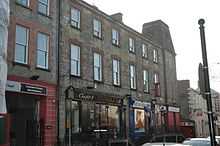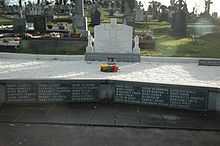Cavan Orphanage Fire
The Cavan Orphanage Fire occurred on the night of 23 February 1943 at St Joseph's Orphanage in Cavan, Ireland. 35 children and 1 adult employee died as a result.[1]

Much of the attention after the fire surrounded the role of the Poor Clares, the order of nuns who ran the orphanage.[2]
History of the Orphanage
The Poor Clares founded a convent in Cavan in 1861 in a large premises on Main Street. As a closed contemplative order the nuns themselves were never seen by the public.
The Industrial Schools Act 1868 provided for the establishment of the Industrial school system in Ireland to provide accommodation and education for orphaned and abandoned children. Most were run by religious orders.
Events of 24 February 1943
It is likely the fire started due to an electrical fault in the laundry housed in the basement of the orphanage. Nothing was noticed until about 2am when one of the girls from the dormitory alerted one of the head nuns.
The sight of smoke coming out of the building also alerted people living on Main Street. They went to the front entrance and tried to gain entry. Eventually they were let in by one of the girls but not knowing the layout of the convent, they were unable to find the girls.
By this time all of the girls had been moved into one Dormitory. At this stage it would have been possible to evacuate all of the children but instead the nuns persuaded the local people to attempt to put out the fire. Two men (John Kennedy and John McNally) went down to the laundry to try to put the fire out. The flames were now too intense for this to be possible and McNally only survived by being carried out by Kennedy.
By this point it was no longer possible for the girls to get out through the main entrance or the fire escape. The local fire brigade had then arrived but their equipment was not sufficient for this fire. In the absence of any other solution girls were encouraged to jump. Some survived by doing this, though with injuries, however most were too frightened to attempt it. By the time a local electricity worker, Mattie Hand, arrived with a long ladder, it was too late. Although a local man, Louis Blessing, went up to the dormitory window and managed to bring down five girls the fire completely engulfed the dormitory and the remaining girls died.
Aftermath and Inquiry
In the immediate aftermath the fire was seen as a tragic accident and much sympathy was expressed to the local Catholic Hierarchy. Over concerns about the causes of the fire and the standard of care, a Public Inquiry was set up. The outcome of this Inquiry absolved the nuns of any blame but was critical of the local fire service. This finding has been disputed by many, including in a piece of verse written by the secretary to the Inquiry Brian O'Nolan, better known as the author Flann O'Brien, and one of the counsel representing the Electiricity Supply Board, Tom O'Higgins, later Chief Justice of the Supreme Court and presidential candidate.

| “ | In Cavan there was a great fire, Judge McCarthy was sent to inquire, |
” |
| —Flann O'Brien & Tom O'Higgins | ||
It was alleged that the nuns prevented firefighters entering the building in case they saw the girls inside in a state of undress.[3]
Due to the nature of the fire, the remains of the dead girls were placed in 8 coffins and buried in Cullies cemetery in Cavan. A new memorial plaque was erected in 2010 just inside the convent gates at Main Street, Cavan. The plaque was anonymously donated to the Friends of the Cavan Orphanage Victims group
Response to Fire
The town did not have any sort of formal or professional fire brigade. Although the of stand-pipes connected to the public water main had recently been improved and increased, the apparatus for delivering water was wholly unsuitable – little more than a cart and a hose pipe (which, according to the inquiry, may have been faulty). There was no pumping equipment and formal, organised structure of fire officers. On the night of the fire, the Brigade in Dundalk was summoned by telephone. By the time the Dundalk Fire Brigade (which was a professional unit) had covered the forty-five or so miles of twisting road, there was nothing to be done. Enniskillen is about ten miles closer to Cavan than Dundalk and the roads are more direct. However, there is nothing to suggest that the Enniskillen Fire Brigade was summoned, even though Northern fire brigades had in the past crossed the border to assist in the South.
In 1950, as a direct result of the inquiry, the Department of Local Government issued a forty-seven-page fire safety recommendation entitled Fire Protection Standards for Public Buildings and Institutions. Its safety instructions covered areas for which "a Department of State has any responsibility or for which [it] has power to make rules or regulations in respect of the maintenance of inmates."[4]
References
- Tribunal of Inquiry into the Fire at St. Joseph's Orphanage, Main Street, Cavan (17 September 1943). Report (PDF). Official publications. P.6144. Dublin: Stationery Office. Retrieved 29 November 2013.
Footnotes
- ↑ Geraghty, Tom; Trevor Whitehead (2004). The Dublin Fire Brigade: a history of the brigade, the fires and the emergencies. Dublin City Council Series. Jeremy Mills Publishing. p. 236. ISBN 978-0-946841-71-4. Retrieved 8 December 2011.
- ↑ http://www.rte.ie/tv/scannal/cavanfire.html
- ↑ Coe, Jonathan (24 October 2013). "Clutching at Railings". London Review of Books 35 (20): 21–22.
- ↑ Fire Protection Standards for Public Buildings and Institutions. Department of Local Government. Dublin: The Stationery Office. 1950. pp. Foreword. Retrieved 8 December 2011.
Further reading
- Arnold, Mavis; Heather Laskey (2004). Children of the Poor Clares. Appletree Press Ltd. ISBN 0-86281-917-2.